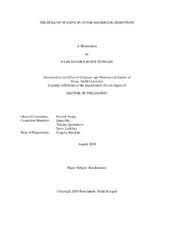| dc.description.abstract | Spanins are bacteriophage lysis proteins responsible for disruption of outer membrane (OM), the last step of phage lysis in Gram-negative hosts. The absence of spanins results in a terminal phenotype of fragile spherical cells. Spanins can be broadly classified into two types: two-component spanins (e.g., ʎ Rz-Rz1) and unimolecular spanins (e.g., T1 gp11). The former consists of two proteins, an integral inner membrane (IM) protein and OM lipoprotein, designated as i-spanin and o-spanin respectively. The two-component spanins interact through their C-termini to form a spanin complex spanning the periplasm and connecting the membranes. In contrast, unimolecular spanins (u-spanins) have an N-terminal OM lipoprotein signal and a C-terminal transmembrane domain (TMD). After maturation and localization, the u-spanin spans the entire periplasm as a single molecule, connecting the membranes with a covalent polypeptide chain. Our model for function of both types of spanins is that destruction of the peptidoglycan (PG) by the endolysin liberates the spanins to diffuse laterally and oligomerize, providing free energy for conformational changes that result in fusion of the IM and OM.
The aim of the research presented here was to a) expand our understanding about two-component and u-spanins through a comprehensive bioinformatics analysis and b) investigate the molecular mechanism of u-spanin function. The bioinformatics study provided insights into spanin function, evolution, and domain organization. In the molecular analysis of gp11, the necessity of membrane localization signals of for function was validated using site-directed mutagenesis. Studies using a C-terminal GFP tagged allele of gp11 indicated localized oligomerization within the PG meshwork. Several regulatory elements, including a truncated “anti-spanin” gene product, were identified. Furthermore, single missense mutations defective in lysis found to be distributed throughout the periplasmic domain of gp11 and shown to exhibit oligomerization defects. The results from a spheroplast fusion assay designed to test our model of gp11 function are also discussed. In summary, this work demonstrates that spanins, like viral membrane fusion proteins, adopt different strategies to achieve fusion of the inner and outer membranes. | en |




